Why Are Granny Annexes Becoming More Popular in the United Kingdom for Elder Care in 2025?
In 2025 in the UK, granny annexes are increasingly used as practical alternatives to traditional elder care. These self-contained units support multigenerational living, lower ongoing care costs, and help older adults retain independence. This article examines reasons, benefits, and considerations.

The landscape of elder care in the United Kingdom is shifting dramatically. Families are increasingly seeking alternatives to residential care homes, driven by rising costs, long waiting lists, and a desire to keep loved ones nearby. Granny annexes have emerged as a compelling solution, blending independence with family support. These purpose-built structures provide elderly relatives with their own space while remaining within the family home environment, addressing both practical and emotional needs in modern caregiving.
What Exactly Is a Granny Annexe?
A granny annexe is a self-contained dwelling typically constructed in the garden or alongside the main family home. These structures include essential living facilities such as a bedroom, bathroom, kitchenette, and living area, allowing elderly occupants to maintain their own routines and privacy. Unlike traditional extensions, granny annexes are often modular or prefabricated units that can be installed relatively quickly without extensive building work. They range from compact single-room studios to more spacious two-bedroom designs, accommodating varying mobility needs and lifestyle preferences. Many modern annexes incorporate accessible features like level-access showers, wider doorways, and emergency call systems, making them suitable for individuals with limited mobility or health concerns.
The Growth of Multigenerational Living and Rising Care Costs
Multigenerational living arrangements are experiencing a notable resurgence across the United Kingdom. Economic pressures, housing shortages, and cultural shifts toward family-centered care have contributed to this trend. Meanwhile, residential care home fees have reached unprecedented levels, with average costs exceeding £40,000 annually in many regions. Families facing these expenses are exploring alternatives that preserve quality of life without depleting savings. Granny annexes address this need by enabling families to pool resources and share caregiving responsibilities. The arrangement also benefits younger family members who may require childcare support or assistance with household tasks, creating a mutually beneficial living dynamic that strengthens intergenerational bonds.
Financial Advantages and Cost Savings Offered by Granny Annexes
The financial case for granny annexes is compelling when compared to long-term residential care costs. While the initial investment varies based on size, specifications, and installation requirements, many families find the expenditure justified over time. A basic granny annexe typically costs between £30,000 and £60,000, with more luxurious or larger models reaching £100,000 or beyond. These figures represent a one-time investment rather than ongoing annual fees. Additionally, granny annexes may increase overall property value, though this depends on local planning regulations and market conditions. Families can also explore funding options including equity release, home improvement loans, or savings, making the investment more accessible. The annexe eliminates or reduces care home fees, transportation costs for family visits, and expenses associated with maintaining a separate household for elderly relatives.
| Provider | Annexe Type | Estimated Cost Range |
|---|---|---|
| Granny Annexe | Modular Studio Unit | £30,000 - £50,000 |
| Annexe Solutions UK | Two-Bedroom Annexe | £60,000 - £90,000 |
| Garden Annexes | Custom Build | £50,000 - £100,000+ |
| Pod Space | Prefabricated Pod | £35,000 - £65,000 |
| Vivid Green | Eco-Friendly Annexe | £45,000 - £85,000 |
Prices, rates, or cost estimates mentioned in this article are based on the latest available information but may change over time. Independent research is advised before making financial decisions.
How Granny Annexes Promote Independence and Support Family Caregiving
One of the most significant advantages of granny annexes is the balance they strike between independence and support. Elderly residents maintain their own living space, daily routines, and sense of autonomy, which contributes positively to mental health and wellbeing. Simultaneously, family members remain nearby to assist with medical appointments, meal preparation, or emergency situations. This proximity reduces the isolation many elderly individuals experience in residential care settings while avoiding the potential tensions that can arise from fully shared living spaces. Family caregivers benefit from reduced stress, knowing their loved ones are safe and accessible without the need for constant supervision. The arrangement also allows elderly residents to remain engaged with family life, participating in gatherings and maintaining relationships with grandchildren.
Innovations in Design and Technology for Elder-Friendly Annexes
Modern granny annexes incorporate thoughtful design features and technological innovations tailored to elderly occupants. Accessibility remains paramount, with level-access entrances, non-slip flooring, and strategically placed grab rails becoming standard features. Smart home technology is increasingly integrated, including voice-activated lighting, temperature controls, and emergency alert systems that connect directly to family members or medical services. Energy-efficient construction methods ensure comfortable living conditions while minimizing utility costs. Some manufacturers offer customizable layouts that accommodate mobility aids, hoists, or future adaptations as needs change. Soundproofing and thermal insulation enhance comfort and privacy, while large windows and outdoor access promote wellbeing through natural light and connection to garden spaces. These design considerations reflect a growing understanding of elder care needs and the importance of creating environments that support dignity and quality of life.
Conclusion
Granny annexes represent a practical and compassionate response to the evolving challenges of elder care in the United Kingdom. By combining financial sensibility with emotional benefits, these structures enable families to provide personalized care while respecting the independence and dignity of elderly relatives. As care costs continue rising and multigenerational living gains acceptance, granny annexes are likely to become an increasingly common feature of British family life. The investment in a well-designed annexe offers not only immediate caregiving solutions but also long-term value, creating flexible living arrangements that adapt to changing family needs over time.



